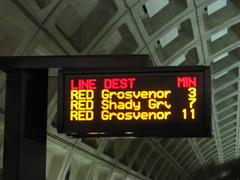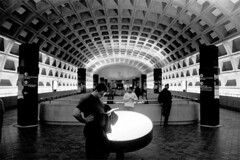Washington Post Series on WMATA: It Isn't Pretty
 Photo by Tom Bridge (via Flickr).
Photo by Tom Bridge (via Flickr).This four part series by Jo Becker and Lyndsey Layton started Sunday and ends today.
Sunday: Efforts to Repair Aging System Compound Metro's Problems: Costly Projects Mismanaged, Records Show. Washington's world-class subway has fallen into decline, and nearly $1 billion spent on projects to upgrade the system has not improved service.
Monday: OFF THE RAILS: Preventable Problems Safety Warnings Often Ignored at Metro: Responses to Derailments, Track Flaws and Station Overruns Have Fallen Short, Records Show. Time and again, the public transit agency has disregarded the advice of experts and failed to address safety issues, a Post review of internal Metro documents shows.
Tuesday: OFF THE RAILS MetroAccess Problems: Service for Disabled Is Troubled: Metro Grapples With Late Rides, High Costs, Fraud Claims MetroAccess, the transportation program for the disabled, has been plagued by poor service, rising costs and dishonest drivers and riders.
Wednesday: OFF THE RAILS : Fitful Money Management: Metro Spending Often Veers From Core Transit Mission Even as Metro officials complain about tight finances, they continue to spend millions on projects that have little to do with the core mission of transporting customers.
More resources on transit in the Washington region
 Photo by Drew McDermott.
Photo by Drew McDermott.Metro Responds to Washington Post Series: Important message from Metro General Manager/CEO Richard White
Sierra Club Metro DC Challenges to Sprawl Campaign on the Metro System.
Washington Regional Network for Livable Communities on Transportation:
WRN advocates transportation investments that provide equitable access, less reliance on automobiles and improved air quality. We promote innovative parking and transportation demand management strategies, an essential component to making transit-oriented development a success. Keys to the solution are: parking pricing that reflects true costs, priority attention to pedestrians and bicyclists, and incentives to ride transit rather than drive. Our advocacy to hold down Metro fares and support for market-rate parking prices to balance Metro's budget helped contain increases in overall rider costs.
Transit
Making the Most of Metro: Community Building though Transit (PDF)
Get on Line: The Purple Line - taking the Washington, DC region into the 21st Century (PDF)
Parking and Transportation Demand Management
Building Healthier Neighborhoods with Metrorail: Rethinking Parking Policies a Chesapeake Bay Foundation Report (PDF)
Neighborhood Parking Solutions: How to manage parking to create better communities, affordable housing and greater access (PDF)
Parking & Transportation Demand Management: Bibliography
Shoring Up Metro Funding for Metro Matters
Our Leaders are Failing Metro
Fighting Metro Fare Increases
2004: Metro Again Passes Costs onto Riders
Another Metro Fare Hike?
Metro Funds Fall Short, Customers Pay More Costs (Intersect v8n3, June 21, 2004)
A Time to Choose Metro or Outer Beltways (Intersect v8n2, April 21, 2004)
Metro Fare Hikes and Service Cuts Loom as Maryland Weakens Support (Intersect v8n1, February 17, 2004)
Metro Board Endorses Fare Increase
2003: Fair Pricing of Metro Parking Benefits Everyone
WRN Comments on Fare Increase Proposal
WMATA Press Release: Budget Committee Recommends Fare Increases
Washington Business Journal op/ed: Metro system to evolve past parking issues
WRN's Press Release (PDF)
Joint Letter to WMATA
A Fare Hike? There's A Better Solution
A Fare Hike? There's A Better Solution Flyer (PDF)
Metro Access Fact Sheet
 Stand Clear of the Doors, by Drew McDermott.
Stand Clear of the Doors, by Drew McDermott.Brookings Institution
Washington's Metro: Deficits by Design
Friends of the Earth/DC Environmental Network
D.C. at the Crossroads (1999). This blueprint is designed to help the District of Columbia with transportation investments and policies that could enhance safety, increase access, reduce traffic, diminish air pollution and promote economic development. While it focuses on D.C., many of the recommendations make sense for any urban area.
Sierra Club
Restore the Core (2000).
Sierra Club releases "Restore the Core" report
Not long ago, the idea of environmentalists supporting development would have seemed absurd. But, with its three-year in the making Restore the Core!/Challenge to Sprawl Campaign, the New Columbia Chapter of the Sierra Club has put a different, decidedly green spin on development in the urban context.
Done well, the Club maintains, development of Washington, D.C. and its inner suburbs restores economic vitality and enhances quality of life in the urban core while helping to stem the staggering suburban sprawl that consumes green space, farmland, tax dollars and time in harried commutes in addition to the investment of millions of dollars in additional infrastructure.
In its newly released report, "Restore the Core! A Citizen's Guide to Building a Livable Washington, DC," the Sierra Club provides an outline for a livable city, from preserving parkland and green space to encouraging development of brownfields and underutilized or vacant lots. The 24-page report examines several areas essential to livable communities: Schools, Public Safety, Employment, Development, Transportation, Green Spaces, Rivers, and Trees. The final two chapters demonstrate how to advocate for a livable DC and provides helpful resources.
While intended as a resource for neighborhood advocates, the guide also provides useful information for architects, planners, developers, and contractors who are interested in developing sites within the city in a way that enhances the surrounding neighborhoods and the city as a whole. Although many of the concepts contained in the report will not be new to those familiar with the principles of sustainability, "Restore the Core" brings home local, applicable examples illustrating what sustainability means here in the District. (Gwyn Jones)



0 Comments:
Post a Comment
<< Home